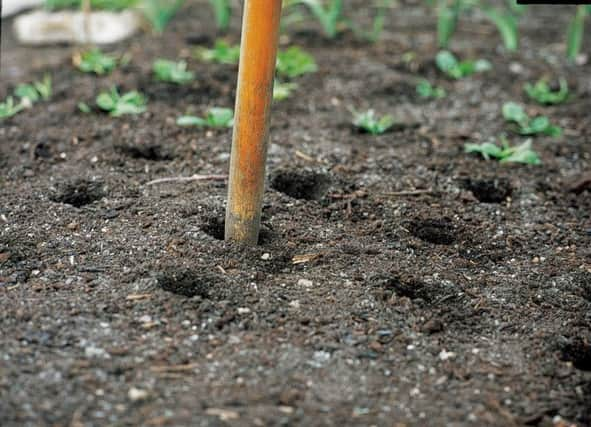Gardening myths uncovered


The Royal Horticultural Society is putting the record straight on a number of old wives’ tales which have worked their way into the gardening psyche.
Here, Guy Barter, RHS chief horticultural adviser, busts open some of the most famous myths.
Advertisement
Hide AdAdvertisement
Hide AdMyth — Ivy kills trees: Guy says: “ Ivy is thought to seldom kill trees of itself, but the presence of ivy indicates the very strong suspicion of root disease especially honey fungus doing serious harm to the host and allowing the ivy to flourish under the diminished canopy.”


Myth — Wild flowers are easy: Guy says: “Gardens are often just too rich and fertile for wild flowers so that the desirable flowers fade away and rampant grasses take over. Mixes of annual flowers that resemble wild flowers on the other hand are easy and highly beneficial to many insects and a wiser choice for fertile gardens
Myth — Water drops on leaves cause burning from the sun’s rays: Guy says: “To focus sunlight, a water droplet needs to be above the leaf, and this can very occasionally happen with hairy-leaved plants (French beans for example) but in almost all cases scorching is not caused by wet leaves. Spraying leaves with pesticides or liquid fertiliser in sunny conditions can cause harm, however, as the water evaporates and the chemicals become concentrated, so can harm foliage.”
Myth — Ground cover plants save work: Guy says: “Depending on the type of plant you use, ground cover plants can soon become so thick that laborious pruning and thinning is required. Sooner or later perennial weeds set up camp in ground cover and have to be winkled-out by hand as weedkillers and hoes cannot be used. Around trees and shrubs ground cover acts as a particularly pernicious ‘weed’ unless carefully controlled.”
Advertisement
Hide AdAdvertisement
Hide AdMyth — Digging is required to control weeds: Guy says: “The main reason for digging weeds is control, as burial of weeds is highly effective. But if weeds are controlled by other means such as mulches, herbicides or shallow hoeing, digging can be dispensed with. The only fly in this ointment is that sometimes weed control by other means can take longer and be harder work than digging, so it is not necessarily true for every site.”


Myth — Raised beds are best for growing crops: Guy says: “Raised beds are a great idea for ill-drained clay soils in wet regions where they enhance drainage and make avoidance of compacting wet soil by trampling easier. But on other soils they enhance drainage to the point of drought (greatly increasing drought susceptibility) and impede flexibility in cropping as sprawling plants are hard to include in a strict defined bed. Therefore gardeners may do a lot of hard work at considerable expense for fewer crops.”
Myth — Moss is always a nuisance in gardens: Guy says: “Moss is a sign that the soil is moist for prolonged periods. This happens when the soil is compacted, acidic or shaded. Moss has no roots and therefore cannot compete significantly with plant roots. In beds and borders it is a useful cover suppressing weed germination and limiting water loss. In lawns moss can indicate areas where perhaps grass should not be grown, under shade for example, where alternative plantings might be required. As moss cannot withstand treading, the presence of moss in lawns can indicate a lack of traffic and suggest that as access is not required then alternatives to lawns can be sought.”
Myth — Plants like being spoken to: Guy says: “With neither ears nor language it seems improbable that the spoken word has much effect on plants, although it may be therapeutic to the chatting gardeners themselves!”
Advertisement
Hide AdAdvertisement
Hide AdBest of the bunch — Bluebell: Bluebells are at their best at this time of year, providing stunning bursts of calming blue hues in woodlands all over the country. The wild bluebell, Hyacinthoides nonscripta, with its scented sapphire bells on slender stems, will create a naturalistic effect in any garden with dappled shade provided by trees or large shrubs. The bulbs should be planted in autumn 4-6cm deep in informal clumps of 20 or more, leaving 3-4cm between the bulbs. If you want them in grass, lift patches of turf and plant them as you would do with narcissi. The Spanish bluebell, Hyacinthoides hispanica, is larger than its English relative, with individual bells bigger and more open, and spreads prolifically.


Good Enough To Eat — Leeks: They are the ideal veg to grow for winter use, are relatively trouble-free and not too fussy about soil conditions. Sow now thinly in a short row in the open ground, covering the seed to a depth of 1cm and water thoroughly. If you sowed them under glass earlier in the year they can be planted out from May to July. They’ll grow in any type of soil and their strong roots help break up heavy ground. When seedlings are around 15cm tall, lift and transplant them, trimming the ends of the leaves and any damaged roots with scissors beforehand. Then make holes with a dibber around 15cm deep and 15cm apart and drop a seedling into each, leaving the top 5cm of foliage above ground and pushing a little soil down into each hole to cover the roots. You can harvest them from early winter, lifting the root with a fork. Good varieties include ‘Musselburgh’ and ‘Oarsman’.